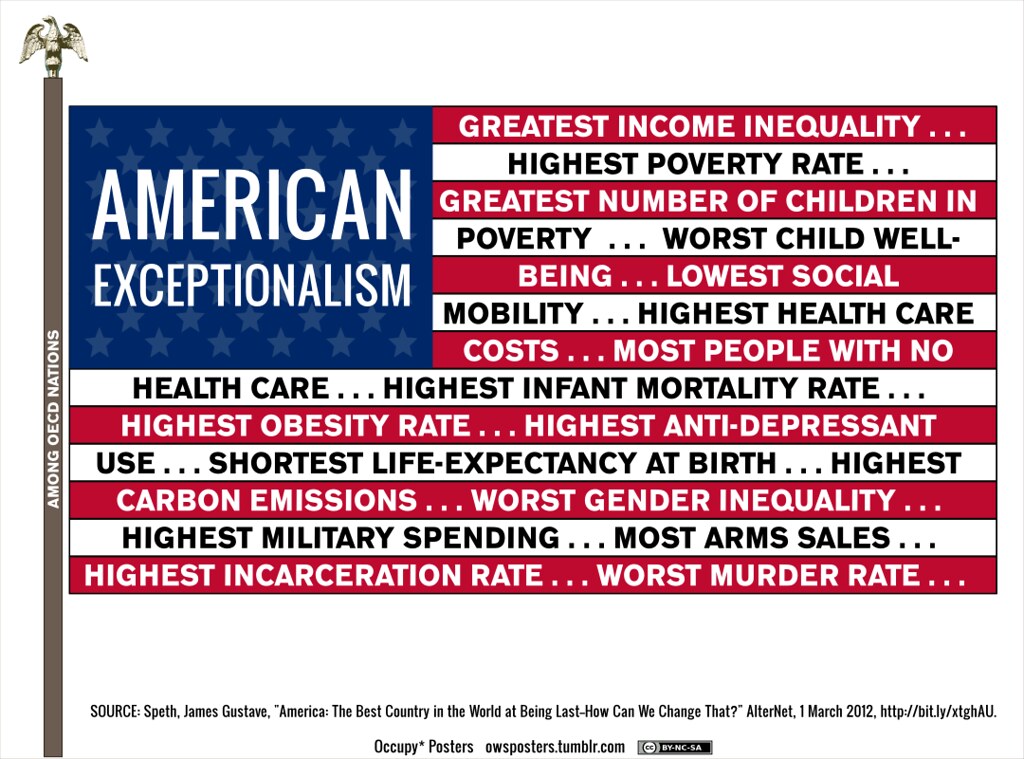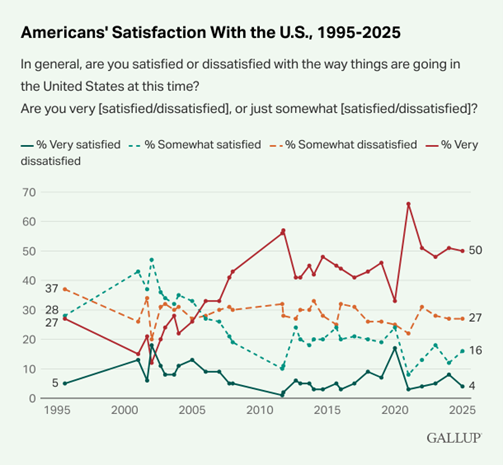Comparing the United States in Global Context: The ‘State of the Nation’ Project and Other Perspectives

Source: Occupy Posters/Flickr
By Wayne A. Selcher, PhD* [Informe OPEU] [American Excepcionalism] [Excepcionalismo americano]
The Rarity of Serious Comparison
Comparativists would do well to be guided by the observation of the late political sociologist Seymour Martin Lipset that “It is impossible to understand a country without seeing how it varies from others. Those who know only one country know no country.” Accordingly, I used some comparative data in previous articles for OPEU, on American “exceptionalism” and political culture and observed that Americans as a whole, including scholars, have shown little or no interest in objectively (and especially systematically) comparing the United States’ actual performance and relative status with those of other countries on a broad scale. National pride and self-confidence have worked against such contextualization for a large percentage of the population for decades—if you consider yourself unique or the best already, why be concerned with ideas, insights, or practices from others? A large 2021 YouGov poll revealed that “Americans tend to believe that the US is indeed the greatest nation on Earth, by 50% to 31%.” A July 2024 Fox News poll concluded that “7 in 10 American voters think the U.S. is the best country in the world to live in… [even though] less than half are proud of the country, and two-thirds don’t trust the federal government and lack confidence in Congress.”
Nationalism, ethnocentrism, parochialism, institutional resistance to major change, more recent doubts about the national role in the world, conservative “America First” opposition to “globalism,” lack of interest or knowledge, and a sense of uniqueness have usually worked to render internationally comparative inquiries about the United States as merely academic in value. The country’s immense territorial and population size, diversity of many sorts, great regional variations, and inequalities make accurate and useful international comparisons methodologically difficult and perhaps contradictory for generalizations at the national level. The public education system is definitely and properly U.S.-centered and does not prioritize study of foreign languages, history, and cultures. There is a strong public focus on domestic issues. The general population has a weak knowledge of and interest in matters beyond U.S. borders that do not directly affect the country, and has recently shown lower support for U.S. involvement abroad.
Nuances in degrees of national pride, however, may expand potential receptivity to ideas and insights from abroad because of more recent national self-doubts and less confidence about the future. A Pew Research survey in 2023 stated that “two-in-ten Americans say the U.S. “stands above all other countries in the world.” About half (52%) say the U.S. is “one of the greatest countries, along with some others,” while 27% say “there are other countries that are better than the U.S.” A 2023 Wall Street Journal/NORC poll showed almost identical results.
Read more about the subject in this article by prof. Wayne Selcher
Because only 4.2 percent of all persons alive today are Americans, the latter certainly stand to learn something from the other 96%, in the other approximately 200 countries in the world, beyond the usual self-congratulatory “I am glad we are not as bad off as those in country XYZ!” In fact, such serious examination may provide some ideas to really make America “great again,” in terms of actual performance on quality of life measures beyond simple campaign slogans. Abundant reliable data is available to identify areas of success and those of underperformance relative to American potential, as more clearly seen in a comparative context of what others have achieved.
The State of the Nation Project
The validity and worth of insights from such comparisons are the premise of the unusual study released in February 2025 and called The State of the Nation, “America’s Progress Report.” With empirical evidence, the project proposes to go beyond the perceptual and interpretative distortions caused by partisan polarization, misinformation and “alternative facts,” and a national spirit of pessimism “to provide an overall assessment of how the country is doing on a wide range of factors that we, and the American people, believe are important.” Sponsored by the Murphy Institute of Tulane University, the product is the result of research and discussion among a “diverse group of thought leaders—from across the political spectrum,” especially from seven leading think tanks and the last five former federal administrations of both parties. A panel of approximately 1,000 citizens also participated, to gauge public opinion and judgement on the issues. Using “37 measures across 15 key topics that capture America’s progress,” the comprehensive undertaking painted the “big picture” by identifying areas of national success and those in which improvement is necessary, while also delineating patterns and trends. Ample attention is given to situations and statistics that require nuances and caveats, with abundant explanation of the methodology and process of the project.
The United States’ record and trends are placed in the context of those of many other countries, with those countries included varying by data source. Results are available in the forms of a full report (138 pages), executive summary (19 pages), and a condensed one-page chart summary. The executive summary presents more thorough analysis and suggestions for improvement. Data sources and methodology notes on selection and use of variables and indicators are included, as well as media coverage of the project. The extensive Data Notes serve as a fine guide to reliable sources for scholars who wish to pursue their own quantitative and qualitative research about the United States, comparative or otherwise. A ninety-minute video of a panel discussion of the project at the Brookings Institution is available.
The investigation discovered considerable bipartisan consensus among such diverse participants and in the public about which areas are successes and which fall short. Overall, the size and complexity of American society relative to others give rise to some findings that seem to be exceptions or contradictory. The executive summary concludes, on balance:
Conclusion #1: We are a nation of extremes—extreme successes and extreme failures.
Conclusion #2: Our national trends are improving in more areas than we are declining. However, relative to other countries, the opposite is true—we are declining in more areas than we are improving.
Conclusion #3: Our economy is poised for continued success.
Conclusion #4: Our rising incomes are not translating into greater perceived well-being and social relations.
Presentation and interpretation of the national and comparative data are complicated and carefully nuanced, including in the tabular form. On balance, on the positive side, this broad international comparison shows that the United States ranks well internationally in these categories: economic output and productivity, average years of education, academic test scores, youths in school or employed, volunteerism, trust in other people, trust in the police, avoiding long-term unemployment, and hourly earnings growth. On the negative side, the United States ranks poorly internationally in these categories: child mortality, healthy birthweight, levels or rates of income inequality, current life satisfaction, life expectancy, social isolation, single-parent homes, mental health issues (especially youth and adult depression and anxiety, fatal overdoses, and suicide), press freedom threats, distrust of institutions (federal government, universities, criminal justice), murder rate, gun violence, voting turnout, inter-party antagonism, questioning of democracy, net greenhouse gas emissions, air quality, employment/population ratio, and labor force participation.
The National Malaise in International Context
While the country has done very well on macroeconomic indicators relative to others since the pandemic, there seems to be little awareness of this fact among the public, in terms of their personal experiences. Most Americans are also not aware of the serious degree of comparative deficiencies that the country exhibits relative to most other democracies. Yet unease about many of these identified shortcomings, rather than the relative accomplishments, figured large in driving the anti-establishment, populist-based results of the November 2024 presidential election, perhaps summarized as concern or malaise in much of the population about declining personal and national well-being.
As the New York Times report on the State of the Nation project noted, “The gap between Americans’ prosperity and quality of life has grown since the 1990s.” The attraction of the winning “Make America Great Again” slogan in response was definitely stronger in 2024 than in the elections of 2016 and 2020. Gallup noted in January 2025 that there was a record low in personal life satisfaction in the public (44 percent “very satisfied,” a status declining since the start of the pandemic), but personal satisfaction on balance was well above the rating for the nation as a whole, which is the constant relationship between those two variables. The survey determined that “More than three-quarters of U.S. adults are ‘very’ (50%) or ‘somewhat’ (27%) dissatisfied with the country, while just one in five are somewhat (16%) or very (4%) satisfied… the percentage of Americans saying they are very dissatisfied has been the largest group since 2006.” That latter category has grown greatly since about 2002, a worrisome sign for the future of the nation.

Source: Gallup, “New Low in U.S. ‘Very Satisfied’ With Personal Life,” January 23, 2025.
American apprehension about the state of the nation, a crisis of confidence, goes far deeper than the issues of price increases, undocumented immigration, and excesses of “wokeness” that figured prominently in the 2024 election campaign. Pride in country is at a “near-record low.” As Pew Research explained in their April 2024 survey on the topic, “‘The American dream’ is a century-old phrase used to describe the idea that anyone can achieve success in the United States through hard work and determination. Today, about half of Americans (53%) say that dream is still possible.” The survey noted that the belief is stronger in the older generations (over 60 percent) and those of higher income (64%) than among those under 50 (42 percent) and of lower income (39 percent).
Public satisfaction with the way democracy is working in the United States plummeted from 52 percent in 2000 to 34 percent in 2025, with 61 percent dissatisfied, according to Gallup. The State of the Nation reported that “Almost two-thirds of high-income countries have more support for democracy than the United States.” The mass media is an essential part of the national dialogue, but in October 2024, 36 percent of the public indicated no trust at all in the mass media and 33 percent registered only “not very much” trust, with strongly negative opinions among Republicans. The number indicating a “great deal/fair amount” of trust in the media has declined steadily from a high of 72 percent in 1976, when coverage of the Watergate scandal and the Vietnam war earned public respect.
Although skepticism about democracy and government is growing in the Western world, international comparison shows clearly that the United States is one of the most affected nations. The country is suffering a deep partisan divide and federal government turmoil and malfunctions as it struggles with issues that may come to endanger its domestic well-being and the type, style, stability, quality, or very existence of its international leadership.
Selected Key Rankings of the United States
To facilitate further study of this emerging topic, below are some additional global ranking positions and classifications of the United States on widely used international scales concerning the quality of democracy and human well-being. Several of these are included in the State of the Nation report as data points, but without dwelling on the detailed findings of each one. All include information on their methodology and interpretation of data. Each one sheds some comparative light on an aspect of the worrisome domestic situation of the United States today, and on the concerns at home and abroad about national decline and its effect on the country’s position in the world.
- Freedom House (2024): Classified as “Free” with a score of 83 out of a possible 100, among 210 countries and territories, where a score of 100 is the most free (as contrasted with “partially free” and “not free”). “However, in recent years its democratic institutions have suffered erosion, as reflected in rising political polarization and extremism, partisan pressure on the electoral process, mistreatment and dysfunction in the criminal justice and immigration systems, and growing disparities in wealth, economic opportunity, and political influence.” Chief weaknesses: political rights scored 33 out of a possible 40 and civil liberties scored 50 out of 60.
- Democracy Index (Economist Intelligence Unit, 2023): Classified as a “flawed democracy,” ranked at 29 out of 167 countries, with a score of 7.85 out of a possible 10, with the weakest areas being in “functioning of government” (6.43 out of 10) and “political culture” (6.25 out of 10).
- Democracy Matrix (University of Würzburg, Germany, 2020): Ranked 36th (“deficient democracy”) among 176 countries, where first place is the “highest quality” democracy, with a score of 8.11 out of 10. (Second highest ranked country among the “deficient democracies”) In 2021, the U.S. was upgraded to a “working democracy,” but with the caveat that “On the other hand, the decrease of quality of democracy is not a short-term trend in the USA but started already in 2015 before Trump was elected in 2017. Still, this conversion is not to be interpreted as a full recovery since the USA are still close to the threshold of a deficient democracy.”
- Fragile States Index (Fund for Peace, 2024) places U.S. in the non-fragile position of 141 among 179 states, with number 179 being the least fragile. Assigns a score of 44.5 out of 100, with 100 with being the most fragile. There is an upswing in the U.S. score since 2018, from 37.7 to 44.5, indicating increased fragility, the latter defined as the inability of a state to overcome the challenges it faces.
- State Resilience Index (Fund for Peace, 2022) ranks the U.S. at 16th in its evaluation of 154 countries, regarding “the extent to which a country can prepare, manage, and recover from a crisis, relative to the severity of that crisis.” The greatest vulnerabilities were located in the areas of environment and social cohesion. State resilience has obvious relevance to recuperation from the numerous and widespread severe tornados, hurricanes, floods, and wildfires that the United States experienced in 2024 and 2025.
- Percentage of Women in Parliament (Inter-Parliamentary Union, January 1, 2025): Ranked 77th out of over 180 countries.
- Human Freedom Index (Cato Institute, 2024): Ranked 17th out of 165 “jurisdictions” in human freedom for 2022 (was 7th in 2000), with a score of 8.64 in human freedom, where 10 is “most free.” The U.S. scored 9.04 in personal freedom (24th rank) and 8.09 in economic freedom (5th rank). The HFI uses perhaps the broadest range of indicators of any of these widely-cited surveys. Greatest weaknesses were in “rule of law” and “freedom of movement.” This assessment by the libertarian Cato Institute is particularly relevant for the United States, where individualism, freedom, and personal responsibility are key values in the political culture and national discourse.
- Corruption Perceptions Index (Transparency International, 2024): Ranked 28th out of 180 countries, where first place is “least corrupt,” with a U.S. score of 65, where 100 is “least corrupt.” This is a drop of four points from its 2023 score of 69, caused by concerns about integrity in the Supreme Court.
- Legatum Prosperity Index (Prosperity Institute, 2023): Ranked 19th out of 167 countries, on the overall score in a wide range of indicators of prosperity. Lowest U.S. rankings among the 167 countries were in safety and security (69th) and health (69th). The highest were in enterprise conditions (3rd), infrastructure and market access (4th), and social capital (9th).
- Human Development Index (United Nations Development Program, 2023-24): Ranked 20th out of 193 countries on a broad composite measure of human well-being (“a long and healthy life, access to knowledge and a decent standard of living”), with a score of 0.927 out of 1.0, for the “Very High human development category.”
- Social Progress Index (Social Progress Imperative, 2023): Ranked 29th out of 170 countries, with a score of 81.7 within a country score range of 25.93 to 90.38. Includes broad measures of well-being. The United States ranked 50th in meeting basic needs, 30th in foundations of wellbeing, 40th in health, 25th in opportunity, 70th in safety, 58th in housing, 30th in inclusive society, 10th in advanced education, 36th in environmental quality, and 24th in freedom and choice, among other rankings.
- World Happiness Report (2024): Ranked 23rd out of 143 countries in positivity of “life evaluation.” Ranked 62nd in regard to happiness level of those below 30 years of age and 10th for those 60 and above. Compared to 2006, in the U.S., “Happiness has decreased in all age groups, but especially for the young, so much so that the young are now, in 2021-2023, the least happy age group.” “There is widespread concern, especially in the United States, about an emerging epidemic of loneliness, and about the consequences of loneliness for mental and physical health.”
- Global Gender Gap Report (World Economic Forum, 2024): Ranked 43rd out of 146 countries in 2024 regarding gender gap, where first place indicates the greatest gender equality in education, economic participation and opportunity, etc. Ranked first (with many others) in educational attainment, 22nd in economic participation and opportunity, 63rd in political empowerment, and 77th in health and survival.
- Index of Economic Freedom (Heritage Foundation, 2024): This conservative think tank, with great influence in the second Trump administration, with Project 2025, gives the U.S. an overall score of 70.1 in economic freedom (barely “mostly free”) out of a possible score of 100, ranking it at 25th among 176 countries. The survey remarked that “Especially notable is the continuing decline within the ‘mostly free’ category of the United States, whose score plummeted to 70.1, its lowest level ever in the 30-year history of the Index,” largely because of continuous huge government spending deficits and debt.
- Economic Freedom (Fraser Institute, 2022): This business-oriented Canadian organization ranks the United States at 5th in the world in economic freedom, among 165 countries, with a score of 8.09 out of 10. This rating is attained mainly by virtue of U.S. strength in ability to trade internationally, sound currency, and reliable business regulations.
- Best Countries (U.S. News and World Report, 2024): Ranked 3rd out of 89 countries in a survey that measures “global performance on a variety of metrics.”

More from this author at OPEU
Informe OPEU “Perspectives on the 2024 Presidential Election and its Immediate Aftermath”, 4/16/25 [Portuguese version available here, translated by Tatiana Teixeira]
Informe OPEU “Trump, MAGA, and the United States Face the November 2024 Presidential Election and Beyond”, 10/10/24 [Portuguese version available here, translated by Wayne Selcher]
Informe OPEU “A Profile of Trump Voters: The Demographics of his MAGA Enthusiasts and Their Relationship to Him”, 9/18/24 [Portuguese version available here, translated by Gabriel Moura and Wayne Selcher]
Informe OPEU “A Profile of Trump Voters: Values and Policy Preferences”, 8/23/24 [Portuguese version available here, translated by Tatiana Teixeira, Post-doctoral researcher (INCT-INEU) and editor of OPEU]
Informe OPEU “The Appeal of Donald J. Trump”, 6/24/24 [Portuguese version available here, translated by Tatiana Teixeira, Post-doctoral researcher (INCT-INEU) and editor of OPEU]
Book review “Eric Hoffer’s ‘The True Believer: Thoughts on the Nature of Mass Movements’”, 3/11/24 [Portuguese version available here, translated by Andressa Mendes, PhD candidate at San Tiago Dantas International Relations Program (Unesp, Unicamp, PUC-SP), Brazil]
Estudos e Análises “American Political Culture in Transition: The Erosion of Consensus and Democratic Norms”, 2/29/24
Estudos e Análises “Is the United States ‘Exceptional’?”, 8/3/21
Publicity “Virtual Library: The Ultimate Online Research Guide”, 4/26/21
Informe OPEU “Suggested Cost-Free Online Sources for U.S. Politics and Foreign Policy”, 6/2/21
* Wayne A. Selcher, PhD, is Professor of International Studies Emeritus, Department of Political Science, Elizabethtown College, PA, USA, and a regular contributor to OPEU. His major academic interests are Comparative Politics, American society and politics in comparative context, American Foreign Policy, Latin American Politics and Foreign Policy (especially Brazil), and Internet use in international studies teaching and research. He is the creator and editor of the WWW Virtual Library: International Affairs Resources, a web guide for online international studies research in many topics. E-mail: wayneselcher@comcast.net.
** Final review and edit: Tatiana Teixeira. First version received in January 25th, 2025. This content does not necessarily reflect the opinion of OPEU, or INCT-INEU.
*** About OPEU, or to contribute articles, contact editor Tatiana Teixeira. E-mail: tatianat19@hotmail.com. About our Newsletters, for press service, or other matters, contact Tatiana Carlotti. E-mail: tcarlotti@gmail.com.
Subscribe to our Newsletter and receive OPEU content by email.
Follow OPEU on Instagram, Twitter, Linkedin and Facebook and follow our daily posts.
Comment, share, send suggestions, be part of our community.
We are a unique Brazilian research observatory on the United States,
with weekly, free, non-profit content.





















